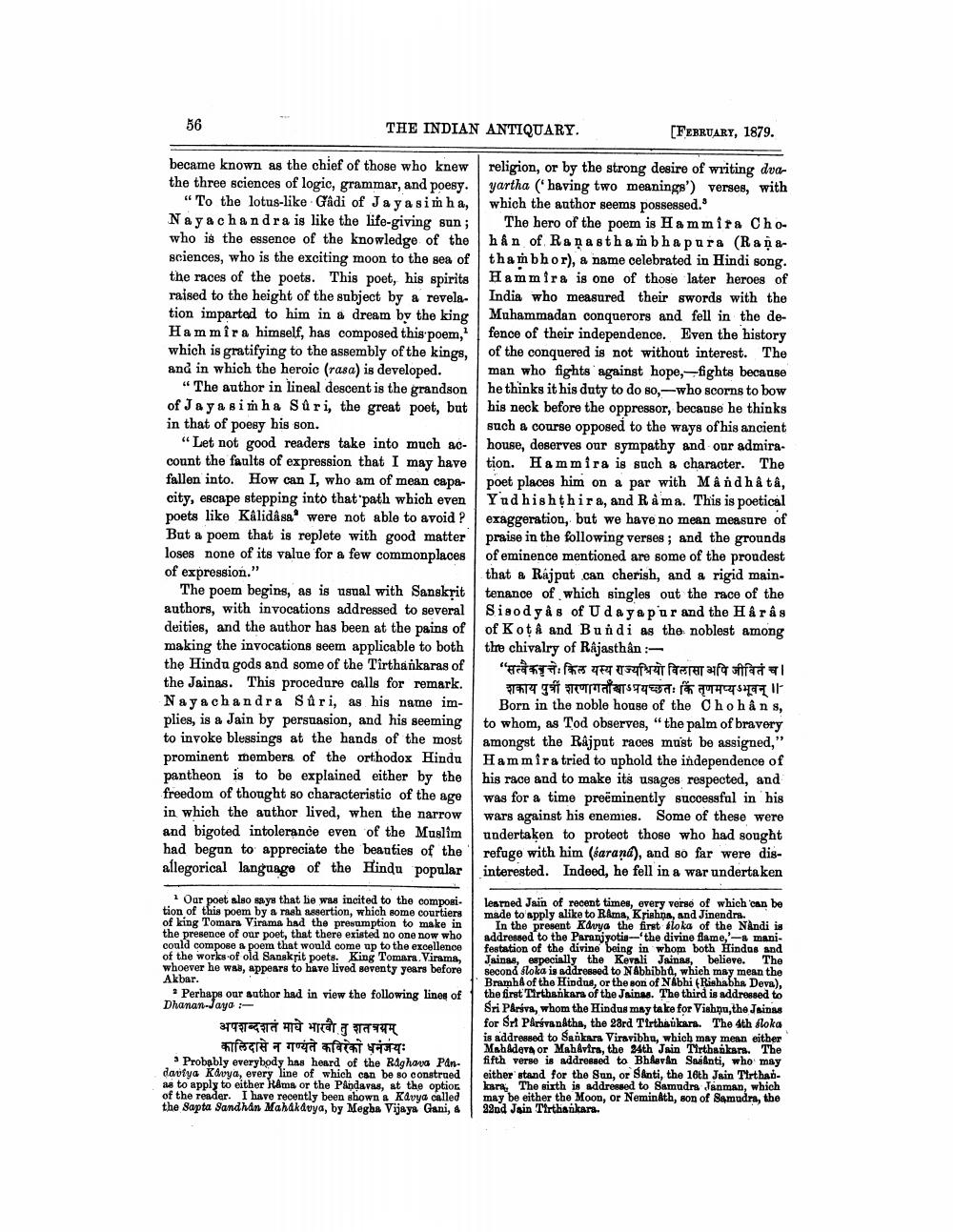________________
56
THE INDIAN ANTIQUARY.
became known as the chief of those who knew the three sciences of logic, grammar, and poesy.
"To the lotus-like Gâdi of Ja y asimha, Nayachandra is like the life-giving sun; who is the essence of the knowledge of the sciences, who is the exciting moon to the sea of the races of the poets. This poet, his spirits raised to the height of the subject by a revelation imparted to him in a dream by the king Hammîra himself, has composed this poem," which is gratifying to the assembly of the kings, and in which the heroic (rasa) is developed.
"The author in lineal descent is the grandson of Jayasimha Sûri, the great poet, but in that of poesy his son.
"Let not good readers take into much account the faults of expression that I may have fallen into. How can I, who am of mean capacity, escape stepping into that path which even poets like Kalidasa were not able to avoid? But a poem that is replete with good matter loses none of its value for a few commonplaces of expression."
The poem begins, as is usual with Sanskrit authors, with invocations addressed to several deities, and the author has been at the pains of making the invocations seem applicable to both the Hindu gods and some of the Tirthankaras of the Jainas. This procedure calls for remark. Nayachandra Sûri, as his name implies, is a Jain by persuasion, and his seeming to invoke blessings at the hands of the most prominent members of the orthodox Hindu pantheon is to be explained either by the freedom of thought so characteristic of the age in which the author lived, when the narrow and bigoted intolerance even of the Muslim had begun to appreciate the beauties of the allegorical language of the Hindu popular
Our poet also says that he was incited to the composition of this poem by a rash assertion, which some courtiers of king Tomara Virama had the presumption to make in the presence of our poet, that there existed no one now who could compose a poem that would come up to the excellence of the works of old Sanskrit poets. King Tomara. Virama, whoever he was, appears to have lived seventy years before Akbar.
Perhaps our author had in view the following lines of Dhanan-Jaya -
अपशब्दशतं माघे भारवौ तु शतत्रयम्
कालिदासे न गण्यते कविरेको धनंजयः
Probably everybody has heard of the Raghava Pandaviya Kavya, every line of which can be so construed as to apply to either Rama or the Pandavas, at the option of the reader. I have recently been shown a Kavya called the Sapta Sandhan Mahakavya, by Megha Vijaya Gani, a
[FEBRUARY, 1879.
religion, or by the strong desire of writing dvayartha ('having two meanings') verses, with which the author seems possessed."
The hero of the poem is Hammira Chohån of Ranasthambhapura (Ranathambhor), a name celebrated in Hindi song. Hammira is one of those later heroes of India who measured their swords with the Muhammadan conquerors and fell in the defence of their independence. Even the history of the conquered is not without interest. The man who fights against hope,-fights because he thinks it his duty to do so, who scorns to bow his neck before the oppressor, because he thinks such a course opposed to the ways of his ancient house, deserves our sympathy and our admiration. Hammira is such a character. The poet places him on a par with Mândhâtâ, Yudhishthira, and R àma. This is poetical exaggeration, but we have no mean measure of praise in the following verses; and the grounds of eminence mentioned are some of the proudest that a Rajput can cherish, and a rigid maintenance of which singles out the race of the Sisodyàs of Udayapur and the Hârâs of Kot and Bundi as the noblest among the chivalry of Rajasthân:
"सत्वैकवृत्तेः किल यस्य राज्यश्रियो विलासा अपि जीवितं च । शकाय पुत्र शरणागतया प्रयच्छतः किं तृणमप्यऽभूवन् ॥ Born in the noble house of the Chohans, to whom, as Tod observes, "the palm of bravery amongst the Rajput races must be assigned," Hammira tried to uphold the independence of his race and to make its usages respected, and was for a time preeminently successful in his wars against his enemies. Some of these were undertaken to protect those who had sought refuge with him (saraná), and so far were disinterested. Indeed, he fell in a war undertaken
learned Jain of recent times, every verse of which can be made to apply alike to Rama, Krishna, and Jinendra.
In the present Kavya the first loka of the Nandi is addressed to the Paranjyotis-the divine flame,'-a manifestation of the divine being in whom both Hindus and Jainas, especially the Kevali Jainas, believe. The second sloka is addressed to Nabhibht, which may mean the Bramha of the Hindus, or the son of Nábhi (Rishabha Deva), the first Tirthankara of the Jainas. The third is addressed to Sri Pariva, whom the Hindus may take for Vishnu,the Jainas for Sri Parsvanatha, the 23rd Tirthankara. The 4th sloka is addressed to Sankara Viravibhu, which may mean either Mahadeva or Mahavira, the 24th Jain Tirthankara. The fifth verse is addressed to Bhavan Sasanti, who may either stand for the Sun, or Santi, the 16th Jain Tirthankara The sixth is addressed to Samudra Janman, which may be either the Moon, or Neminath, son of Samudra, the 22nd Jain Tirthankara.




